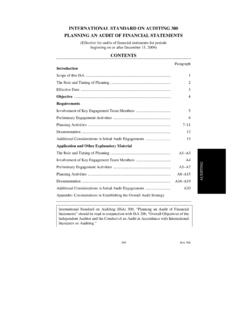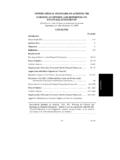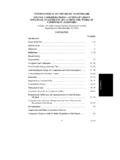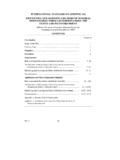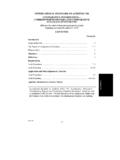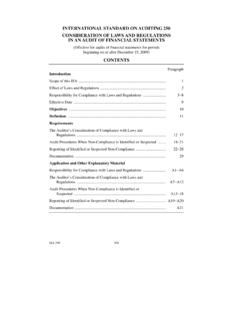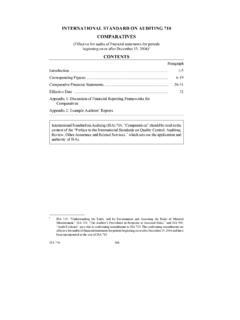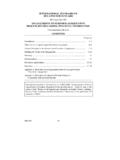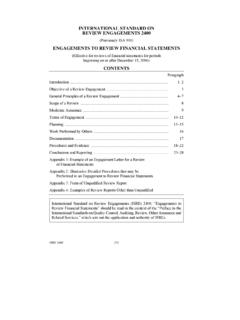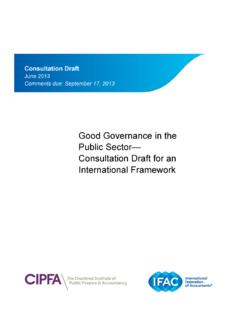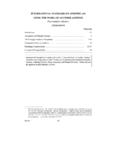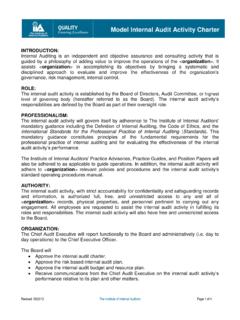Transcription of PREFACE TO THE INTERNATIONAL STANDARDS ON …
1 PREFACE TO THE INTERNATIONAL STANDARDS ON quality . control , auditing , review , other assurance AND. RELATED SERVICES. (Approved December 2006). (Effective as of December 15, 2008)1. CONTENTS. Paragraph 1-2. The IAASB's 3. The Authority Attaching to INTERNATIONAL STANDARDS Issued by the INTERNATIONAL auditing and assurance STANDARDS Board .. 4-9. INTERNATIONAL STANDARDS on auditing .. 10-29. The Authority Attaching to Practice Statements Issued by the INTERNATIONAL auditing and assurance STANDARDS 30-31. other Papers Published by the INTERNATIONAL auditing and assurance STANDARDS Board .. 32. 33. 1. This effective date is provisional, but it will not be earlier than December 15, 2008. 1. PREFACE TO THE INTERNATIONAL STANDARDS ON quality control , auditing , review , other assurance AND RELATED SERVICES. Introduction 1. This PREFACE to the INTERNATIONAL STANDARDS on quality control , auditing , review , other assurance and Related Services ( INTERNATIONAL STANDARDS or IAASB's STANDARDS ) is issued to facilitate understanding of the scope and authority of the pronouncements the INTERNATIONAL auditing and assurance STANDARDS Board (IAASB) issues, as set forth in the IAASB's Terms of Reference.
2 2. The IAASB is committed to the goal of developing a set of INTERNATIONAL STANDARDS generally accepted worldwide. IAASB members act in the common interest of the public at large and the worldwide accountancy profession. This could result in their taking a position on a matter that is not in accordance with current practice in their country or firm or not in accordance with the position taken by those who put them forward for membership of the IAASB. The IAASB's Pronouncements 3. The IAASB's pronouncements govern audit, review , other assurance and related services engagements that are conducted in accordance with INTERNATIONAL STANDARDS . They do not override the local laws or regulations that govern the audit of historical financial statements or assurance engagements on other information in a particular country required to be followed in accordance with that country's national STANDARDS . In the event that local laws or regulations differ from, or conflict with, the IAASB's STANDARDS on a particular subject, an engagement conducted in accordance with local laws or regulations will not automatically comply with the IAASB's STANDARDS .
3 A professional accountant should not represent compliance with the IAASB's STANDARDS unless the professional accountant has complied fully with all of those relevant to the engagement. The Authority Attaching to INTERNATIONAL STANDARDS Issued by the INTERNATIONAL auditing and assurance STANDARDS Board 4. INTERNATIONAL STANDARDS on auditing (ISAs) are to be applied in the audit of historical financial information. 5. INTERNATIONAL STANDARDS on review Engagements (ISREs) are to be applied in the review of historical financial information. 6. INTERNATIONAL STANDARDS on assurance Engagements (ISAEs) are to be applied in assurance engagements dealing with subject matters other than historical financial information. 7. INTERNATIONAL STANDARDS on Related Services (ISRSs) are to be applied to compilation engagements, engagements to apply agreed upon procedures to information and other related services engagements as specified by the IAASB. 8. ISAs, ISREs, ISAEs and ISRSs are collectively referred to as the IAASB's Engagement STANDARDS .
4 9. INTERNATIONAL STANDARDS on quality control (ISQCs) are to be applied for all services falling under the IAASB's Engagement STANDARDS . 2. PREFACE TO THE INTERNATIONAL STANDARDS ON quality control , auditing , review , other assurance AND RELATED SERVICES. INTERNATIONAL STANDARDS on Auditing2. 10. ISAs are written in the context of an audit of financial statements3 by an independent They are to be adapted as necessary in the circumstances when applied to audits of other historical financial information. 11. The objective of an audit of financial statements is to enable the auditor to express an opinion whether the financial statements are prepared, in all material respects, in accordance with an applicable financial reporting framework. It is undertaken to enhance the degree of confidence of intended users in the financial statements. ISAs, taken together, provide the STANDARDS for the auditor's work in fulfilling this objective. 12. In conducting an audit, the overall objective of the auditor is to obtain reasonable assurance about whether the financial statements as a whole are free from material misstatement, whether due to fraud or error, and to report on the financial statements in accordance with the auditor's findings.
5 In all cases when this overall objective has not been or cannot be achieved, the ISAs require that the auditor modifies the auditor's opinion accordingly or withdraws from the engagement. 13. The auditor applies each ISA relevant to the audit. An ISA is relevant when the ISA is in effect and the circumstances addressed by the ISA exist. 14. The ISAs deal with the general responsibilities of the auditor, as well as the auditor's further considerations relevant to the application of those responsibilities to specific topics. An ISA. contains objectives and requirements together with related guidance in the form of application and other explanatory material. It may also contain introductory material that provides context essential to a proper understanding of the ISAs, and definitions. It is, therefore, necessary to consider the entire text of an ISA to understand and apply its requirements. ISA Objectives 15. Each ISA contains an objective or objectives, which provide the context in which the requirements of the ISA are set.
6 The auditor aims to achieve these objectives, having regard to the interrelationships amongst the ISAs. For this purpose, the auditor uses the objectives to judge whether, having complied with the requirements of the ISAs, sufficient appropriate audit evidence has been obtained in the context of the overall objective of the auditor. Where 2. The terms and concepts in this PREFACE are explained further in the ISAs, in particular in ISA 200, Objective and General Principles Governing an Audit of Financial Statements. (ISA 200 will be revised, inter alia, to incorporate the provisions of this PREFACE that deal with the obligations of the auditor, and the status and authority of objectives, requirements and other material. When the proposed revised and redrafted ISA 200 is exposed for public comment in 2007, respondents will be able to comment on this material in that new context.). 3. Unless otherwise stated, financial statements mean financial statements comprising historical financial information.
7 4. Referred to hereafter as the auditor.. 3. PREFACE TO THE INTERNATIONAL STANDARDS ON quality control , auditing , review , other assurance AND RELATED SERVICES. an individual objective has not been or cannot be achieved, the auditor considers whether this prevents the auditor from achieving the auditor's overall objective. Requirements 16. The requirements of each ISA are contained in a separate section and expressed using the word shall. The auditor applies the requirements in the context of the other material included in the ISA. 17. The auditor complies with the requirements of an ISA in all cases where they are relevant in the circumstances of the audit. In exceptional circumstances, however, the auditor may judge it necessary to depart from a relevant requirement by performing alternative audit procedures to achieve the aim of that requirement. The need for the auditor to depart from a relevant requirement is expected to arise only where the requirement is for a specific procedure to be performed and, in the specific circumstances of the audit, that procedure would be ineffective.
8 18. A requirement is not relevant only in the cases where: the ISA is not relevant; or the circumstances envisioned do not apply because the requirement is conditional and the condition does not exist. The auditor is not required to comply with a requirement that is not relevant in the circumstances of the audit; this does not constitute a departure from the requirement. Application and other Explanatory Material 19. The application and other explanatory material contained in an ISA is an integral part of the ISA as it provides further explanation of, and guidance for carrying out, the requirements of an ISA, along with background information on the matters addressed in the ISA. It may include examples of procedures, some of which the auditor may judge to be appropriate in the circumstances. Such guidance is, however, not intended to impose a requirement. 20. Appendices, which form part of the application and other explanatory material, are an integral part of an ISA.
9 The purpose and intended use of an appendix are explained in the body of the related ISA or within the title and introduction of the appendix itself. Introductory Material and Definitions 21. Introductory material may include, as needed, such matters as explanation of: the purpose and scope of the ISA, including how the ISA relates to other ISAs; the subject matter of the ISA; specific expectations on the auditor and others; and the context in which the ISA is set. 22. An ISA may include, in a separate section under the heading Definitions', a description of the meanings attributed to certain terms for purposes of the ISAs. These are provided to assist in the consistent application and interpretation of the ISAs, and are not intended to override definitions that may be established for other purposes, whether in law, regulation or otherwise. Unless otherwise indicated, those terms will carry the same meanings throughout the ISAs. The Glossary of Terms in the Handbook contains a complete listing of terms defined in the ISAs.
10 It also includes descriptions of other terms found in ISAs to assist in common and consistent interpretation and translation. 4. PREFACE TO THE INTERNATIONAL STANDARDS ON quality control , auditing , review , other assurance AND RELATED SERVICES. INTERNATIONAL STANDARDS on quality control 23. ISQCs are written to apply to firms in respect of all their services falling under the IAASB's Engagement STANDARDS . The authority of ISQCs is set out in the introduction to the ISQCs. other INTERNATIONAL STANDARDS 24. The INTERNATIONAL STANDARDS identified in paragraphs 5-7 contain basic principles and essential procedures (identified in bold type lettering and by the word should ) together with related guidance in the form of explanatory and other material, including appendices. The basic principles and essential procedures are to be understood and applied in the context of the explanatory and other material that provides guidance for their application. It is therefore necessary to consider the entire text of a Standard to understand and apply the basic principles and essential procedures.
